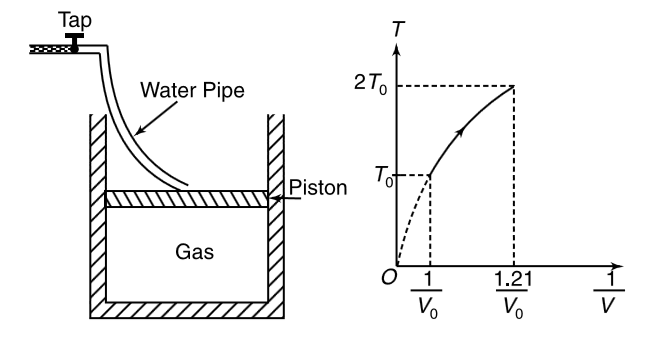A sealed box was found which stated to have contained alloy composed of equal parts by weight of two metals A and B. These metals are radioactive, with half lives of 12 years and 18 years. Respectively and when the container was opened it was found to contain 0.53kg of A and 2.20kg of B. The age of the alloy is M×10+n then find M−n
The correct Answer is:3
Use the law of radioactivity
NA=N0Ae(−λAt)
NB=N0Be(−λet)
Divide (2) by
NBNA=e(λA−λB)t (Because N0A=N0B)
t=1(λA−λB)ln(NBNA)
Given NBNA=2.20.53=4.15
λA=0.693T1/2(A)=0.69312=0.05775years−1
λB=0.693T1/2(B)=0.69318=0.0985years−1
we find age of alloy t=74years
7×10+4
M=7
n=4
M−n=3
Topper's Solved these Questions
- NUCLEAR PHYSICSBook:RESONANCEChapter:NUCLEAR PHYSICSExercise:Exercise-2 Part-3 One more than one options correct type
Explore 7 Videos
- NUCLEAR PHYSICSBook:RESONANCEChapter:NUCLEAR PHYSICSExercise:Exercise-2 Part-4 Comprehension
Explore 6 Videos
- NUCLEAR PHYSICSBook:RESONANCEChapter:NUCLEAR PHYSICSExercise:Exercise 2 Part-1 Only one option correct type
Explore 20 Videos
- GRAVITATIONBook:RESONANCEChapter:GRAVITATIONExercise:HIGH LEVEL PROBLEMS
Explore 16 Videos
- REVISION DPPBook:RESONANCEChapter:REVISION DPPExercise:All Questions
Explore 444 Videos
Similar Questions
A sample contains 10−2kg each of two substances A and B with half lives 4 sec and 8 sec respectively. Their atomic wights are in the ratio 1:2. Find the amounts of A and B after an interval of 16 seconds.
View SolutionA vessel contains N molecules of an ideal gas. Dividing mentally the vessel into two halves A and B, find the probability that the half A contains n molecules. Consider the cases when N=5 and n=0,1,2,3,4,5.
View Solution
Knowledge Check
A and B are two radioactive substances whose half lives are 1 and 2 years respectively. Initially 10gm of A and 1gm of B is taken. The time (approximate) after which they will have same quantity remaining is.
A6.62yrB5yrC3.2yrD7yrA and B are two radioactive substances whose half lives are 1 and 2 years respectively. Initially 10gm of A and 1gm of B is taken. The time (approximate) after which they will have same quantity remaining is.
A6.62yrB5yrC3.2yrD7yrRadioactive elements were incorporated into the earth when the solar system formed All rocks and minerals contain tiny amount of these radioactive elements which breakdown spontaneously into more stable atoms overtime A commonly used radiometric dating technique relies on the breakdown of .19K40 to .18Ar40 precise measurements of the amount of K40 relative to Ar40 in an igneous rock can tell the age of rock
An igneous rock sample was found to contain 0.2 gm potassium and 0.6 gm of Ar The age of the igneous rock is (λofK40=6.93×10−10year−1)A1.2×108 yearsB2×109 yearsC2×1010 yearsD2.4×109 years
In the chemical analysis of a rock the mass ratio of two radioactive isotopes is found to be 100:1. The mean lives of the two isotopes are 4×109 years and 2×109 years, respectively. If it is assumed that at the time of formation the atoms of both the isotopes were in equal propotional, calculate the age of the rock. Ratio of the atomic weights of the two isotopes is 1.02:1.
View SolutionA cylindrical container has insulating wall and an insulating piston which can freely move up and down without any friction. It contains a mixture of ideal gases. Originally the gas is at atmospheric pressure P0 and temperature (T0). A tap positioned above the container is opened and it supplies water at a constant rate of dmdt=0.25kg/s. The water collects above the piston in the container and the gas compresses. The tap is kept open till the temperature of the gas is doubled. During the process the T vs 1V graph for the gas was recorded and found to be a parabola with its vertex at origin as shown in the graph. Area of piston A=1.515×10−3m2 and atmospheric pressure =105N/m2
(a) Find the ratio of Vrms and speed of sound in the gaseous mixture.
(b) For how much time the tap was kept open?

View Solution(a) List the factors on which the rate of a chemical reaction depends.
(b) The half-life for the decay of radioactive 14C is 5730 years. An archaeological artifact containing wood has only 80% of the 14C activity as found in living trees. Calculate the age of the artifact.
View SolutionA radioactive sample contains two different types of radioactive nuclei. A-with half-time 5 days and B-type nuclei is 64 times that of B type of nuclei . Their decay rates will be equal when time a 9n days. Find the value of n.
View SolutionA metal wire of negligible mass, length 1 m and cross-sectional area 10−6m2 is kept on a smooth horizontal table with one end fixed on the table. A ball of mass 2kg is attached to the other end of the wire. When the wire and the ball are rotated with angular velocity of 20 rad/s, it is found that the wire is elongated by 10−3m. If the Young's modulus of the metal is n×1011N/m2, then the value of n is
View Solution

